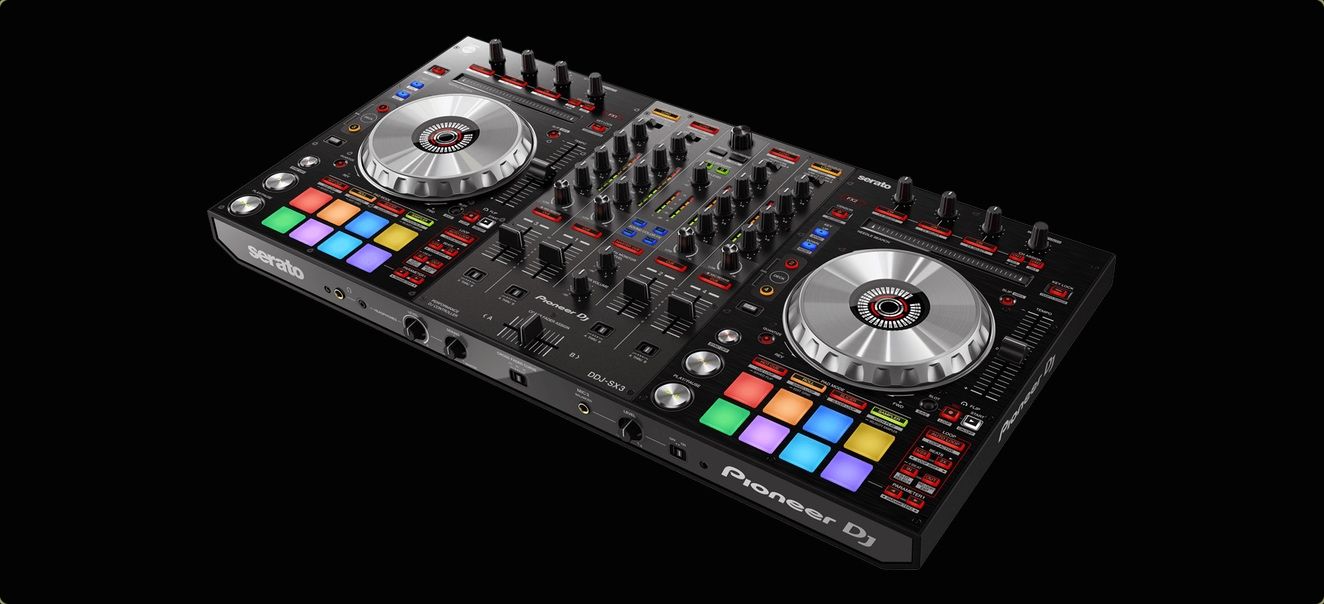Comprehensive review of the Pioneer DDJ-SX3 Serato-compatible controller. Explore advanced connectivity, performance pad modes, sound color effects, microphone features, and club-standard usability. Best for mobile and professional DJs seeking versatility.
Pioneer DDJ-SX3 Review: A Feature-Packed Serato Pro Controller for Versatile DJs
The Pioneer DDJ-SX3 represents the pinnacle of Serato DJ Pro controller design, delivering premium build quality, advanced pad modes, tactile effects, and versatile connectivity for both club and mobile DJs. This thorough editorial review explores its strengths, creative performance tools, user experience, and what sets it apart for modern DJ demands.
Robust Build and Professional Connectivity
Built with a sturdy metal faceplate and ergonomically arranged plastic and rubber controls, the SX3 is designed for heavy use in clubs, studios, or on the road. Powered via mains, the controller features dual USB ports for seamless laptop handovers or back-to-back sets.
Connectivity options abound: XLR and RCA master out for high-quality audio, booth output for monitor speakers, and quarter/eighth-inch headphone outputs. The four RCA inputs enable independent stand-alone mixer functionality, allowing external CDJs or turntables to be integrated for hybrid setups.
Advanced Microphone and Headphone Features
A unique strength of the SX3 is its sophisticated microphone section. With three balanced mic inputs (two assignable, one front-panel), DJs have full control over mic levels, compression, reverb, EQs, and output routing, all adjustable via Serato’s utility window. This is ideal for mobile DJs or clubs requiring multiple hosts and performers.
Headphone mixing is equally robust, with dedicated level and mixing knobs for mastering cue states, enabling tight monitoring even in complex multi-channel mixes.
Performance Pads: Unlocking Creative Potential
Eight highly responsive rubber performance pads open the door to a vast array of modes:
- Hot Cue: Up to eight different cue points for on-the-fly juggling.
- Roll: Temporarily loops the track at varying beat fractions, ideal for breakdowns and build-ups.
- Slicer: Breaks tracks into eight slices for live remixing and beat manipulation.
- Sampler: Trigger one-shots or loops from Serato’s sampler, with dedicated volume control for seamless integration into a mix.
Each pad mode includes shift-access options:
- Cue Loop: Instantly loops a hot cue when triggered.
- Saved Loop: Access up to eight pre-saved loops for creative transitions.
- Slicer Loop: Keeps the track looping within the current slicer section.
- Pitch Play: Use pitch controls (with Serato Pitch & Time DJ add-on) to transpose tracks by up to seven semitones from any cue, enabling sophisticated tone play routines.
Sound Color and Channel Effects
Four independent sound color effects mirror Pioneer’s club mixers: filter, echo, and more. These effects work in both Serato and stand-alone mixer mode, allowing clubs to transition between digital DJing and analog sources without sacrificing performance capabilities.
The effects knobs atop each deck can be assigned to combine Isotope-powered effects from Serato, unleashed on any channel for deep creative expression.
Software Integration: Serato DJ Pro Expansion
The SX3 hardware is designed to maximize Serato DJ Pro, integrating tightly with its expansion packs: Flip for live edits, Pitch & Time DJ for advanced pitch play, and more. Serato Flip, included out-of-the-box, unlocks the ability to create custom edits, from short mixes to radio versions and layered cue routines.
Dual USB support and channel selectors (USB A/B) ensure seamless switching between DJ libraries for collaborative performances and quick handovers.
Usability, Workflow, and Suitability
The tactile controls, club-standard layout, and thoughtful pad arrangements make the SX3 intuitive for seasoned DJs, while its robust mixing options suit mobile professionals, club installs, and event DJs handling weddings, corporate gigs, or busy party sets.
Pros
- Four-channel, club-standard design
- Three independent microphone inputs with advanced effects and routing
- Eight responsive performance pads, extensive modes (cue, roll, slicer, sampler, pitch play, saved loops)
- Dual USB for easy changeovers/back-to-back sets
- Stand-alone mixer: works with external decks
- Sound color effects for digital and analog sources
- Bundled Serato expansion packs (Flip, Pitch & Time DJ)
- Compact for mobile setups, robust for club installs
Cons
- Premium price tier
- Best suited for Serato DJ Pro; limited native support for other software
- Complexity may be daunting for true beginners
Editorial Verdict: Who Should Choose the DDJ-SX3?
Pioneer’s DDJ-SX3 stands out as the ultimate tool for DJs demanding flexibility, creative power, and professional usability. Whether performing at clubs, mobile events, or collaborative handovers, its advanced pad modes, extensive connectivity, and Serato integration ensure top-tier performance in any setting.
For serious DJs ready to expand their routines, manage multiple inputs, and utilize Serato’s most advanced features, the SX3 is a future-proof investment. Its rich feature set, reliability, and intuitive design make it a defining choice in the modern DJ controller landscape.


